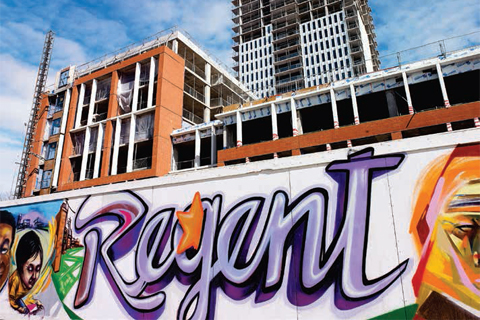When Carolyn Acker, executive director of the Regent Park Community Health Centre, and Norman Rowen (MEd 1977), established a homework support program called Pathways to Education in the neighbourhood in 2001, their goal was straightforward. They wanted to reduce the area’s dropout rates, and all the associated social crises that accrue when young people fall between the cracks of the school system. They decided to try a novel formula: group mentoring and intensive tutoring, as well as TTC tickets and a $4,000 scholarship for those who complete the program and go on to post-secondary education.
Over the years, OISE students have volunteered to tutor in the program, and a handful, such as PhD candidate Robert Kohls, have invested hundreds of hours. “He’s worked with our students with learning challenges to really support their progress,” says program director Sharmini Fernando.
OISE scholars, Fernando notes, are working with the Pathways tutoring team on a research project looking at whether vocabulary enhancement leads to improved academic performance among youth from the Regent Park area, especially those who have English as a second language or whose parents are newcomers to Canada. Over 40 Pathways students are involved. “It’s important to have this community campus connectivity and to do work that OISE and our students will get something out of,” she says.
While that research isn’t complete, the overall Pathways program is increasingly recognized as a model for improving educational outcomes among at-risk kids. More than a decade after its inception, the model has been adopted in several communities across Canada, including Halifax and Winnipeg.
According to data collected by Pathways that compared student cohorts before and after the introduction of the voluntary program, high school graduation and attendance rates increased across the board, often dramatically. In Regent Park, pre-Pathways graduation rates hovered in the 25 per cent range. In the years since the program began, those figures have more than doubled. And participation in postsecondary education and training has skyrocketed – a 300 per cent jump.
Nor are those results limited to Regent Park. In low-income communities in suburban Toronto, Ottawa, and Kitchener, Ontario, the introduction of Pathways programs has led to similarly sharp increases in graduation rates.
The program has attracted millions in private, corporate and foundation support, as well as funding from Queen’s Park and the federal government. In 2007, the late David Pecaut and the Boston Consulting Group conducted a costbenefit assessment. The group’s report focused on “identifiable and quantifiable benefits,” such as higher taxes paid (on higher incomes earned) and reduced government transfer payments, and found, according to Pathways, “that for every one dollar invested in Pathways, a $24 social return on investment was generated for the broader community.”
Pathways alumna Shequita talks about her experience with the tutoring program.
Recent Posts
U of T’s 197th Birthday Quiz
Test your knowledge of all things U of T in honour of the university’s 197th anniversary on March 15!
Are Cold Plunges Good for You?
Research suggests they are, in three ways
Work Has Changed. So Have the Qualities of Good Leadership
Rapid shifts in everything from technology to employee expectations are pressuring leaders to constantly adapt






